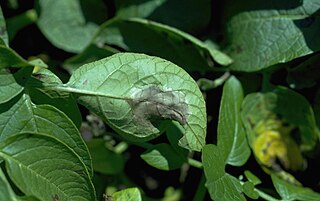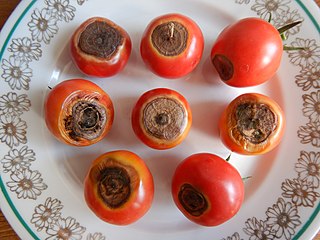
The potato is a starchy tuber of the plant Solanum tuberosum and is a root vegetable and a fruit native to the Americas. The plant is a perennial in the nightshade family Solanaceae.

Phytophthora infestans is an oomycete or water mold, a fungus-like microorganism that causes the serious potato and tomato disease known as late blight or potato blight. Early blight, caused by Alternaria solani, is also often called "potato blight". Late blight was a major culprit in the 1840s European, the 1845 - 1852 Irish, and the 1846 Highland potato famines. The organism can also infect some other members of the Solanaceae. The pathogen is favored by moist, cool environments: sporulation is optimal at 12–18 °C (54–64 °F) in water-saturated or nearly saturated environments, and zoospore production is favored at temperatures below 15 °C (59 °F). Lesion growth rates are typically optimal at a slightly warmer temperature range of 20 to 24 °C.

The Colorado potato beetle, also known as the Colorado beetle, the ten-striped spearman, the ten-lined potato beetle, or the potato bug, is a major pest of potato crops. It is about 10 mm long, with a bright yellow/orange body and five bold brown stripes along the length of each of its elytra. Native to the Rocky Mountains, it spread rapidly in potato crops across America and then Europe from 1859 onwards.
Rebecca J. Nelson, is an American biologist and a professor at Cornell University and a MacArthur Foundation Fellow.
Wild potato may refer to:
Solanum bulbocastanum, the ornamental nightshade, is a plant in the family Solanaceae, native to Mexico and parts of the U.S. Southwest. It is closely related to the potato and, as it has evolved strong resistance to all known varieties of potato blight, has been used to genetically engineer resistance into the cultivated varieties of potatoes around the world. The use of genetic engineering is helpful, as efforts to hybridize by traditional methods have so far been unsuccessful, and the use of somatic hybridization to transfer genes is difficult. A resistance to the Columbia root-knot nematode Meloidogyne chitwoodi has been identified in S. bulbocastanum, which can be transferred to cultivated potato.

Alternaria solani is a fungal pathogen that produces a disease in tomato and potato plants called early blight. The pathogen produces distinctive "bullseye" patterned leaf spots and can also cause stem lesions and fruit rot on tomato and tuber blight on potato. Despite the name "early," foliar symptoms usually occur on older leaves. If uncontrolled, early blight can cause significant yield reductions. Primary methods of controlling this disease include preventing long periods of wetness on leaf surfaces and applying fungicides. Early blight can also be caused by Alternaria tomatophila, which is more virulent on stems and leaves of tomato plants than Alternaria solani.

Bintje is a middle-early ripening potato variety bred in the Netherlands by the Frisian schoolmaster K.L. de Vries in 1904 from and marketed for the first time in 1910. The name of the potato, a diminutive of Benedict, was borrowed from one of his former students.
Superior is a white-skinned, white-fleshed, mid-season potato variety. It was released by the University of Wisconsin potato breeding program in 1962, and is not under plant variety protection. It is a progeny of a cross between 'B96-56' and 'M59.44' and was first grown in 1951. 'B96-56' was also a parent of Kennebec. Like the potato variety Atlantic, Superior is widely grown for potato chip manufacturing right off the field and marketable yields are fairly high.
Redcliffe Nathan Salaman was a British physician, pathologist, botanist and potato breeder. His landmark work was the 1949 book The History and Social Influence of the Potato, which established the history of nutrients as a new literary genre.

Melody is a cultivar of potato.

A genetically modified potato is a potato that has had its genes modified, using genetic engineering. Goals of modification include introducing pest resistance, tweaking the amounts of certain chemicals produced by the plant, and to prevent browning or bruising of the tubers. Varieties modified to produce large amounts of starches may be approved for industrial use only, not for food.
Kiwellin is a protein prevalent in cell walls of plants. It is one of the most abundant proteins found in kiwifruits and is known to be an allergen in humans. In maize it works as part of its defense mechanism against corn smut. and may also be part of the tomato and potato plants defense mechanism against potato blight
Solanum acaule is a species of wild potato in the family Solanaceae, native to Peru, Bolivia, northern Chile, and northwestern Argentina. It is being extensively studied for its resistance to Phytophthora infestans, Potato leafroll virus, Potato virus X, Potato virus Y, potato cyst nematodes, and frost, in an effort to improve the domestic potato Solanum tuberosum.

Solanum commersonii is a species of wild potato in the family Solanaceae. It is native to southern Brazil, Uruguay, and northeastern Argentina, and has been introduced to Mauritius. It is being extensively studied for its resistance to root knot nematode, soft rot, blackleg, bacterial wilt, verticillium wilt, Potato virus X, tobacco etch virus, common scab, and late blight, and for its frost tolerance and ability to cold acclimate, in an effort to improve the domestic potato Solanum tuberosum.
Solanum demissum is a species of wild potato in the family Solanaceae, native to Mexico and Guatemala. It has been extensively used as a source of alleles for resistance to Phytophthora infestans, the cause of late potato blight, to improve the domestic potato Solanum tuberosum.
Solanum palustre is a species of wild potato in the family Solanaceae. It is native to central and southern Chile, and Neuquén and Río Negro Provinces of Argentina. Although it does not bear tubers, it is still being extensively studied for its resistance to Potato virus Y, Potato leafroll virus, early blight, late blight, common scab, bacterial soft rot, and frost.
Solanum pinnatisectum, the tansy-leaf nightshade or tansyleaf nightshade, is a species of flowering plant in the family Solanaceae, native to Arizona in the United States, and to Mexico. A wild potato, it is being extensively studied for its resistance to Phytophthora infestans, in an effort to improve the domestic potato Solanum tuberosum.
Solanum verrucosum is a species of wild potato in the family Solanaceae, native to Mexico. It is typically found in cloud forests at 2,100–3,500 m (6,900–11,500 ft) above sea level. Its tubers are small and late to develop, but said to be quite tasty.







